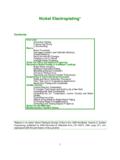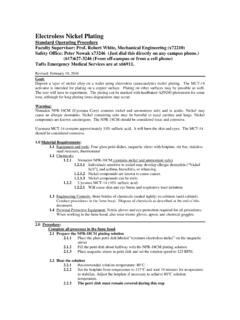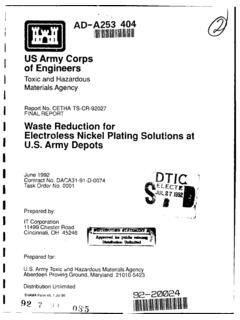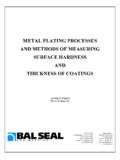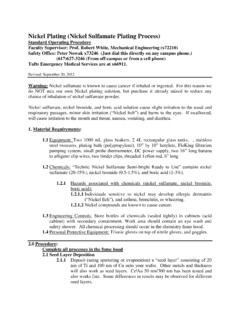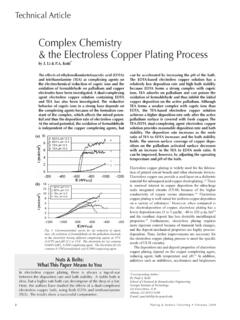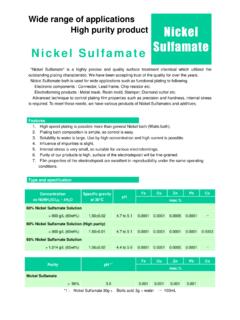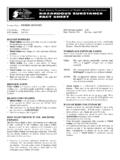Transcription of Chapter 3 Troubleshooting Electroless Nickel Plating Solutions
1 Chapter 3 Troubleshooting Electroless Nickel Plating Solutions Michael J. Aleksinas The chemical reduction potential of the Electroless Nickel Plating reaction can be affected by many factors; hence, Troubleshooting these Solutions can be difficult and time-consuming. A working knowledge of the chemistry of the Electroless process, coupled with the selection of the proper pretreatment techniques, is necessary to insure reliable, consistent results. In order quickly and effectively to solve the technical problems that may arise, it is first necessary to outline the typical problems that can arise. These problems can be categorized into four basic groups: Bath chemistry imbalance Improper substrate preparation/activation Equipment/mechanical problems Solution contamination By taking a logical approach to these four categories, Troubleshooting can be accomplished effectively and efficiently.
2 BATH CHEMISTRY Compohents of the Electroless bath include an aqueous solution of Nickel ions, reducing agent@) (NaH2P02, DMAB, etc.), complexing agent(s), buffer@), and stabilizer(s). These components work in concert with each other and operate in specific concentration, temperature and pH ranges. Optimizing these parameters can be different from solution to solution. Maintaining the optimum metal content, reducer concentration, pH and temperature of the solution can minimize many of the technical problems that can arise. Analytical techniques to determine these parameters can be obtained from text books or from suppliers. One of the first and easiest bath parameters to be checked is pH. The pH is determined by pH meter or pH paper. Caution should be used here because some pH papers may differ from the electrometric readings by as much as pH units. In some Electroless processes, pH papers can give erroneous values because of the salt-ion effect of the solution.
3 As an Electroless bath ages, there 101 102 Electroless Plating is a buildup of ions such as NH4', Na', K', SO,', Cl-, etc., and all can contribute to the change in ionic strength of the solution. Consequently, pH paper may act differently in new Solutions than in old Solutions . Electrometric pH readings are preferred. Calibration of the pH meter is mandatory for reliable information. Electrometric pH meters require standardization between two units of the pH scale ( , 4 and 7). One buffer solution should be above the expected pH of the sample to be measured, while the second buffer should be below. Once the. meter is standardized to both of these standards, the solution pH can be measured. A common error in reading pH accurately is temperature variations between the bath sample and the two buffers. The proper procedure is to have identical temperatures for both the buffers and the sample.
4 Thus, a hot bath sample should be cooled to room temperature or the buffer Solutions should be heated to the same temperature as the sample. A high pH value of the Plating solution can cause abnormally high Plating rates that may lead to roughness, pitting, and/or cloudy deposits. Too low of a pH will cause slow deposition rates and matte/dull finishes. The temperature of the solution should also be closely monitored for consistent high quality deposits. Accurate temperature controllers are necessary. Checking temperature controllers with certified thermometers provides further assurance that temperatures are maintained at proper levels. Unchecked temperatures can lead to decomposition of the Plating bath (temperature too high) or no Plating at all (temperature too low). Finally, solution imbalance as a result of poor maintenance of the Nickel and/or reducing agent concentrations can give slow Plating rates, poor coverage, and dull deposits.
5 Maintaining the Nickel and reducing agent concentrations within 10 to 15 percent will usually provide consistency in terms of rate, color, and stability. Periodic analysis of these constituents is required, with the frequency of analysis proportional to the workload being processed. Excessively large replenishments can lead to overstabilization or suppressed rates, as many of the components used for replenishment often contain high concentrations of stabilizers and/or brighteners, which may act as catalytic poisons. In "home-brew'' situations, where commodities such as pH adjusters, metal salts, and reducing agents are added to the Plating Solutions , only high-purity chemicals from an approved source should be used. Low cost chemicals have often been found to contain impurities that may lead to pitting, dullness, or suppressed Plating rates. Insoluble materials can also be present, which will cause roughness or act as nuclei for the spontaneous decomposition of the bath.
6 Keeping records of replenishment additions, pH adjustments, and temperature readings provides valuable information for maintaining the chemistry balance of the solution. Automatic controllers have proven useful if they themselves are closely monitored. The use of controllers avoids large additions to the Plating bath and eliminates the possibility of bath over- stabilization. When bath parameters are found to fall within the given ranges and Troubleshooting Electroless Nmkel Plating Solutions 103 problems still exist, then such circumstances as inadequate surface preparation and/or contamination of the bath should be examined. SUBSTRATE ACTIVATION Proper preparation of the substrate to be plated is vital for quality results. Poor surface preparation can cause lack of adhesion, deposit porosity, roughness, non-uniform coatings and/or dark deposits. A properly prepared substrate is one whereby surface contamination is removed, which leaves a clean, nominally oxide-free surface.
7 Typical surface contaminants that must be removed (or replaced) priorto Plating usually include one or more of the following: Oils, lubricants Buffing compounds Oxide films (replaced on AI) 0 Weld scale 0 Fluxes Depending on the type of soils present, different pretreatments are needed. Pretreatment choice should be the best available for the specific substrate and should be closely monitored. Cleaners and pickling Solutions should be changed at predetermined intervals to eliminate the possibility of ineffective cleaners and descalers, which will cause poor adhesion, streaky deposits, or blistering. The quality of the substrate itself also must be checked carefully as a potential problem source. Often Plating problems resulting from inferior substrates are wrongfully diagnosed as pretreatment or bath chemistry problems; for example, intermetallic compounds at aluminum substrate surfaces can manifest themselves as nodules or pits in the final plate.
8 In other cases, porous castings or powdered metal substrates can entrap Solutions , which result in bleedout or voids. The way in which a part is stamped, cast, drilled, or machined can have a great impact on the final plated product. Improperly stamped parts can imbed difficult-to-remove oils or compounds into the surface of the part. This will lead to dull and'often non-adherent coatings. Improper temperature control while casting aluminum or zinc die cast parts can cause lamination of the substrate, which witl lead to uneven appearance in the end plate. Obviously then, much attention must be focused upon the raw part itself. By noticing imperfections early, problems can be avoided later in the Plating process itself. Pretreatment of various substrates is covered extensively in another section of this book. EQUIPMFNT/MECHANlCAL NEEDS When bath parameters appear to be satisfactory and pretreatment processes are in order, the next area of concern is the type of equipment and the mechanical 104 Electroless Plating techniques that are being used.
9 Electroless Nickel Solutions should have constant filtration to eliminate any particulate bath impurities such as dust, sand, or loose maskant material. With proper filtration (210 turnovedhr at 5 pm or less), roughness of the final deposit can be greatly reduced or even eliminated. Replacement of these filters on a regular basis is recommended so that retention of pore size of these filters is maintained. Since Electroless Plating is an autocatalytic process, it is vital to remove all foreign particulates so that plate- out will be virtually eliminated. Plate-out, if allowed to occur, can lead to roughness of the deposit, bath decomposition, and excessive Plating costs. The typeof heating that is used in the Plating process is also of great concern. Electroless Nickel Plating tanks can be heated internally or externally. Excessive localized overheating can cause plate-out, roughness, or even bath decomposition.
10 Lack of agitation of the Plating solution can also cause problems. Solution stratification can occur, resulting in gas pitting, patterns, and/orstreaking of the deposit. Proper agitation allows uniform distribution of Plating chemicals and helps to eliminate localized overheating. Work-rod agitation or clean, filtered air is suitable for most Electroless Nickel Solutions . Agitation of thesolution or parts is necessary to provide a fresh supply of solution to the parts, and to enhance the removal of hydrogen gas produced during deposition. In most cases, high-temperature, stress-relieved polypropylene is the material of tank construction. Etched tanks can become more active towards Electroless processes and should be replaced to minimize plate-out on the tank walls. Stainless steel may also be used as an alternative for tank construction. A small anodic charge will minimize plate-out on these tank walls.
